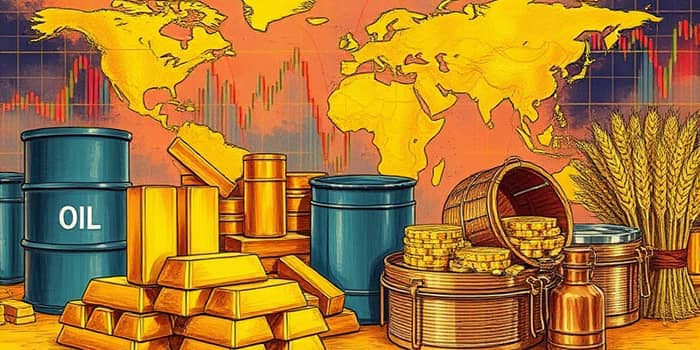Commodities trading unlocks the world of buying and selling primary raw materials across global markets. Whether you’re seeking to hedge risk, diversify portfolios, or capture profit from market swings, understanding this asset class is critical for success.
Definition and Overview
Commodities trading involves the buying and selling of raw materials like oil, gold, wheat, and more. Unlike stocks, these are tangible assets with intrinsic value tied to physical supply and demand. Traders and investors aim to profit from price fluctuations, hedge against adverse moves, and achieve portfolio diversification.
These markets are foundational to global commerce, enabling producers and consumers to manage cost uncertainties while offering speculators avenues for gains.
Types of Commodities
Commodities are generally split into hard and soft categories, representing extracted and grown products. They also align with major sectors driving the global economy:
- Energy: Oil, natural gas
- Precious metals: Gold, silver
- Industrial metals: Copper, aluminum
- Agricultural: Wheat, coffee, corn, soybeans
Each category responds to distinct supply pressures—geopolitics for energy, mining cycles for metals, and weather patterns for agriculture.
Methods of Trading
Participants can access commodities through a range of instruments, each suited to specific goals and risk appetites:
- Spot trading: Immediate exchange at current market prices, common for perishable goods.
- Futures trading: Contracts to buy or sell at a preset future date and price, minimizing uncertainty for producers and buyers.
- Options trading: Rights without obligations to transact at a fixed price—offering risk-limiting benefits.
- CFDs, ETFs, and mutual funds: Indirect exposure for retail investors via derivative or pooled structures.
Futures remain the dominant mechanism, facilitating standardized contracts and deep liquidity on major exchanges.
How Commodities Markets Function
At the core, supply and demand dynamics drive price movements. Factors such as economic conditions, technological shifts, and geopolitics can rapidly alter market sentiment.
Price discovery occurs on platforms like the Chicago Mercantile Exchange (CME), New York Mercantile Exchange (NYMEX), and London Metal Exchange (LME). These venues provide transparent order books, standardized contract specifications, and robust regulatory oversight.
Key Players
The interplay of different participants shapes market behavior:
- Producers/Consumers: Oil companies, airlines, and farmers.
- Speculators: Financial traders seeking to profit, adding market liquidity.
- Hedgers: Entities mitigating price risk through contract positions.
- Brokers/Banks: Intermediaries facilitating transactions for retail and institutional clients.
Speculators and hedgers together ensure markets remain deep and efficient.
Major Global Commodities and Volumes
The sheer scale of commodity markets is staggering, with annual trade values reaching trillions of U.S. dollars. Below are representative figures:
These metrics highlight the enormous liquidity and economic importance of commodities.
Benefits of Commodities Trading
One major advantage is portfolio diversification, since commodity prices often move independently from stocks and bonds. This can reduce overall portfolio risk and enhance returns.
Commodities also function as an inflation hedge, preserving purchasing power when currency values decline. Hard assets like gold and oil tend to hold value during inflationary periods.
Lastly, traders can profit from volatility, capitalizing on price swings driven by geopolitical events, supply disruptions, or unexpected demand shifts.
Risks and Challenges
Despite the potential rewards, commodities trading involves significant hurdles. High volatility can lead to rapid losses. Leverage inherent in derivatives introduces leverage risk, magnifying gains and losses alike.
Physical delivery obligations, though rare, pose logistical and storage challenges. Additionally, participants face regulatory risk, navigating evolving rules across multiple jurisdictions and incurring hefty compliance costs.
Instances of market abuse, such as manipulation and insider trading, continue to draw scrutiny, with authorities imposing substantial penalties to protect market integrity.
Regulatory and Compliance Environment
Oversight comes from agencies including the Commodity Futures Trading Commission (CFTC), Securities and Exchange Commission (SEC), and European Securities and Markets Authority (ESMA). Firms must comply with trade reporting standards, maintain transparent records, and enforce anti-money laundering protocols.
Compliance demands significant investment in systems, audits, and expert personnel. Failures can result in fines of hundreds of millions USD and lasting reputational damage.
Emerging technologies like algorithmic strategies and blockchain are increasingly adopted to automate surveillance, enhance reporting accuracy, and strengthen risk management.
Popular Strategies for Traders
Hedging is employed by producers and consumers to lock in prices, protecting against adverse market moves and ensuring predictable revenues or costs.
Speculative trading seeks to profit from anticipated price changes, utilizing margin to amplify returns—balanced by the higher risk of substantial losses.
Arbitrage exploits price disparities between markets or contract maturities, contributing to arbitrage-driven market efficiency and price convergence.
Getting Started
Beginners typically open an account with a regulated broker, specifying their margin tolerance and selecting instruments such as futures, options, or commodity-focused ETFs.
Education is paramount: simulation or paper trading accounts, webinars, and dedicated courses build essential skills before allocating real capital.
Implementing robust risk management—stop-loss orders, position sizing, and diversification—helps safeguard against significant drawdowns.
Outlook and Trends for 2025 and Beyond
The global push for sustainable energy is boosting demand for battery metals such as lithium, cobalt, and nickel, while traditional oil and gas remain critical to the energy mix.
Climate-related regulations, supply chain vulnerabilities, and geopolitical tensions will continue to create price volatility and trading opportunities.
Digitalization, including AI-driven analytics, algorithmic trading, and decentralized contract settlement on blockchain platforms, is transforming market access, efficiency, and transparency.
Commodities trading offers a dynamic frontier for investors seeking to diversify portfolios, hedge risks, and capitalize on global economic trends. By mastering market fundamentals, deploying disciplined strategies, and embracing evolving technologies, traders can navigate this complex landscape with confidence and purpose.
References
- https://www.poems.com.sg/glossary/trading-terms/commodities-trading/
- https://wearehubpay.com/resources/compliance-strategies-and-key-challenges-in-commodity-trading
- https://naga.com/en/academy/commodities-trading
- https://www.bitedata.io/playbooks/commodities-futures-trading-compliance
- https://www.ebc.com/forex/what-is-commodity-trading-learn-how-beginners-can-profit
- https://redstonesearch.com/how-regulatory-compliance-impacts-commodity-trading-careers/
- https://www.activtrades.com/en/news/commodities-trading-explained-what-you-need-to-know
- https://www.steel-eye.com/industry-commodity-trading-firm










